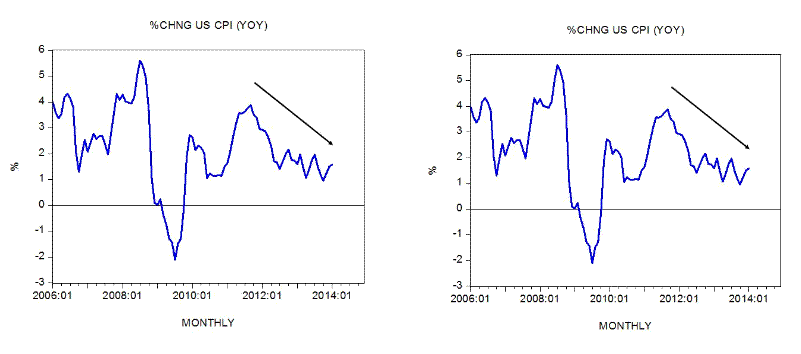Inflation Does Not Produce Economic Growth
Economics / Inflation Mar 17, 2014 - 06:31 PM GMTBy: Frank_Shostak
 After settling at 3.9 percent in July 2011 the yearly rate of growth of the consumer price index (CPI) fell to 1.6 percent by January this year. Also, the yearly rate of growth of the consumer price index less food and energy displays a visible downtrend falling from 2.3 percent in April 2012 to 1.6 percent in January.
After settling at 3.9 percent in July 2011 the yearly rate of growth of the consumer price index (CPI) fell to 1.6 percent by January this year. Also, the yearly rate of growth of the consumer price index less food and energy displays a visible downtrend falling from 2.3 percent in April 2012 to 1.6 percent in January.
On account of a visible decline in the growth momentum of the consumer price index (CPI) many economists have concluded that this provides scope for the US central bank to maintain its aggressive monetary stance.

 Some other economists, such as the president of the Chicago Federal Reserve Bank’s Charles Evans are even arguing that the declining trend in the growth momentum of the CPI makes it possible for the Fed to further strengthen monetary pumping. This, Evans holds, will reverse the declining trend in price inflation and will bring the economy onto a path of healthy economic growth. Evans also asserts that the Fed should be willing to let inflation temporarily run above its target level of 2 percent. He also said that an unemployment rate of about 5.5 percent and an inflation rate of about 2 percent are indicative of a healthy economy.
Some other economists, such as the president of the Chicago Federal Reserve Bank’s Charles Evans are even arguing that the declining trend in the growth momentum of the CPI makes it possible for the Fed to further strengthen monetary pumping. This, Evans holds, will reverse the declining trend in price inflation and will bring the economy onto a path of healthy economic growth. Evans also asserts that the Fed should be willing to let inflation temporarily run above its target level of 2 percent. He also said that an unemployment rate of about 5.5 percent and an inflation rate of about 2 percent are indicative of a healthy economy.
But how is it possible that higher price inflation will make the economy stronger? If price inflation slightly above 2 percent is good for the economy, why not aim at a much higher rate of inflation, which will make the economy much healthier?
Contrary to Evans a strengthening in monetary pumping to lift the rate of price inflation will only deepen economic impoverishment by allowing the emergence of new bubble activities and by the strengthening of existing bubble activities.
It will increase the pace of the wealth diversion from wealth generators to various non-productive activities, thereby weakening the process of wealth generation.
Evans and other economists are of the view that a strengthening in monetary pumping will strengthen the flow of monetary spending, which in turn will keep the economy stronger.
In this way of thinking, an increase in the monetary spending of one individual lifts the income of another individual whose increase in spending boosts the incomes of more individuals, which in turn boosts their spending and lifts the incomes of more individuals, etc.
If, for whatever reasons, people curtail their spending this disrupts the monetary flow and undermines the economy. To revive the monetary flow it is recommended that the central bank should lift monetary pumping. Once the monetary flow is re-established this sets in motion self-sustaining economic growth. So it is held.
Again we suggest that monetary pumping cannot set in motion self-sustaining economic growth. It can only set in motion an exchange of something for nothing (i.e., economic impoverishment).
As long as the pool of real wealth is still growing, monetary pumping can create the illusion that it can grow the economy. Once however, the pool is declining the illusion that the Fed’s loose policies can set in motion economic growth is shattered.
If, on account of the deterioration of the infrastructure, a baker’s production of bread per unit of time is now 8 loaves instead of 10 loaves, and the shoemaker’s production per unit of time is now 4 pairs of shoes instead of 8 pairs of shoes, then no amount of money printing can lift the production of real wealth per unit of time (i.e., of bread and shoes). Monetary pumping cannot replace non-existent tools and machinery.
On the contrary, the holders of newly-printed money who don’t produce any real wealth will weaken the ability of wealth generators to produce wealth by diverting to themselves bread and shoes, thereby leaving less real wealth to fund the maintenance and the expansion of the infrastructure.
Now, Fed officials give the impression that once they put the economy onto the so-called self-sustained growth path the removal of the monetary stimulus will not generate major side effects. But in reality a loose monetary policy sets in motion bubble activities. The existence of these activities is supported by monetary pumping, which diverts to bubble activities real wealth from wealth generating activities.
Once monetary pumping is aborted, bubble activities are forced to go under since they cannot fund themselves without the support of loose monetary policy. An economic bust ensues. The illusion that the Fed can bring the economy onto a self-sustaining growth path is shattered.
Conclusion
On account of a visible decline in the growth momentum of the US price index, many economists have concluded that this provides scope for the Fed to maintain its aggressive monetary stance. Some economists such as the president of the Chicago Federal Reserve Bank, Charles Evans, even argue that the declining trend in the growth momentum of the CPI makes it possible for the Fed to further strengthen monetary pumping. This, it is held, will reverse the declining trend in price inflation and will bring the US economy onto a path of healthy economic growth. We suggest that contrary to Evans, a strengthening in monetary pumping will only deepen economic impoverishment by allowing the emergence of new bubble activities and by the strengthening of existing bubble activities.
Frank Shostak is an adjunct scholar of the Mises Institute and a frequent contributor to Mises.org. He is chief economist of M.F. Global. Send him mail. See Frank Shostak's article archives. Comment on the blog.![]()
© 2014 Copyright Frank Shostak - All Rights Reserved Disclaimer: The above is a matter of opinion provided for general information purposes only and is not intended as investment advice. Information and analysis above are derived from sources and utilising methods believed to be reliable, but we cannot accept responsibility for any losses you may incur as a result of this analysis. Individuals should consult with their personal financial advisors.
© 2005-2022 http://www.MarketOracle.co.uk - The Market Oracle is a FREE Daily Financial Markets Analysis & Forecasting online publication.



